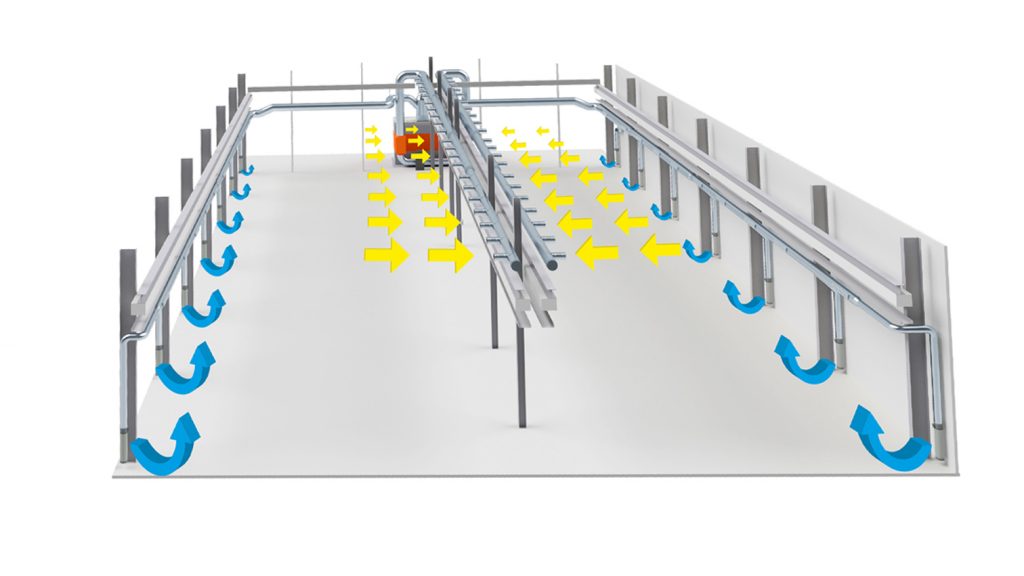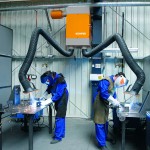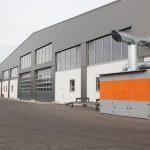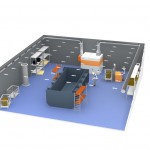Nine reasons why general ventilation systems make sense for metal processing companies
Air quality in the entire production area is becoming ever more important. General ventilation systems play an increasingly important role in effective occupational health and safety. They are always only a supplement to source extraction. Nevertheless, nine reasons show why the purchase of a workshop ventilation system is worthwhile for metal processing companies.
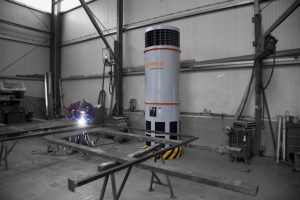 General ventilation systems are increasingly important whenit comes to effective occupational health and safety. Occupational safety officers are turning their sights on the air quality in the entire production hall. Because, not only the individual welder himself, but also the employees at surrounding workplaces must be protected. General ventilation systems signal to the employees that their employers not only ensure the health protection of the welders, but also protect the health of all employees.
General ventilation systems are increasingly important whenit comes to effective occupational health and safety. Occupational safety officers are turning their sights on the air quality in the entire production hall. Because, not only the individual welder himself, but also the employees at surrounding workplaces must be protected. General ventilation systems signal to the employees that their employers not only ensure the health protection of the welders, but also protect the health of all employees.
Basically, however, the following always applies: Source extraction first! The sole purpose of general ventilation systems is to clean the ambient air. General ventilation systems must not be used as the sole capturing element at the source of welding fumes. This is because welding fumes should not be able to develop outside the working area in the first place. Nine points show why they are nevertheless suitable for occupational safety:
1. General ventilation systems are the optimal supplement to source extraction
Of course, general ventilation systems should ’only’ be used as a supplement to source extraction. Because simply by capturing welding fumes directly at the point of origin, welders prevent hazardous substances from spreading throughout the production hall. Source extraction is the most effective method of reliably capturing welding fumes. However, the complete detection of all welding fumes cannot be achieved by source extraction in reality. Even 80 percent would be a very good value in everyday working life.
The human factor in particular stands in between: Often welders do not follow the extraction hood consistently or do not position it correctly (Read here how to do it correctly). What is not collected there is distributed throughout the entire hall air. If companies cannot comply with limit values by means of source extraction alone, further technical measures – such as the integration of general ventilation systems or the separation of individual work areas – must be taken. Only then do organisational, and lastly personal, protective measures follow.
2. Problem with large workpieces and frequent position changes
Welders know this from daily practice: There are cases where source extraction is not possible because they cannot get close enough or because they constantly changes position, as in the case of stapling. In these situations, a lot of welding fumes escape.
While welders can protect themselves with personal protective equipment, companies must prevent welding fume clouds from spreading in production – as a protective measure for all employees in production as well as to act in compliance with the law. Where source extraction reaches its limits, general ventilation systems supplement occupational health and safety. If there is no source extraction when welding stainless steel, for example, companies must use general ventilation systems in exhaust mode.
3. General ventilation systems are mandatory today for certain welding processes
Whereas source extraction should generally be sufficient for welding processes with low to medium hazard classes, additional occupational safety equipment is already required for welding processes with a high to very high hazard class. This means both personal protective equipment for the welder himself as well as general ventilation systems for the protection of other employees. Welding processes with high to very high hazard classes include manual arc welding, MIG welding, MAG welding and electric arc spraying.
4. Different designs for different operational needs
There’s no such thing as one general ventilation system. Depending on the individual requirements, the tailor-made room air concept for metalworking companies can be created using a variety of systems. With general ventilation systems, they have the choice between so-called layer or mixed ventilation systems.
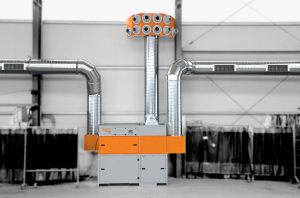 Mixing ventilation systems rely on the dilution effect. Layer ventilation systems, on the other hand, use the thermal lift of the welding fumes. The air is extractedand filtered at a height of four to six metres. The clean air is returned to the lower part of the hall again, thus expelling atmospheric impurities from the welders’ area. For welding fumes, this is the most effective type of general ventilation and hence the reason why it is also recommended for this purpose.
Mixing ventilation systems rely on the dilution effect. Layer ventilation systems, on the other hand, use the thermal lift of the welding fumes. The air is extractedand filtered at a height of four to six metres. The clean air is returned to the lower part of the hall again, thus expelling atmospheric impurities from the welders’ area. For welding fumes, this is the most effective type of general ventilation and hence the reason why it is also recommended for this purpose.
It is implemented via central filter systems and connected piping systems. Most filter towers also work according to this principle. Mixing ventilation systems that are used for unclear or low thermal conditions include die systems with jet nozzles as well as so-called push-pull systems. They generate a horizontal flow of air in the hall, which is intended to drive soiling towards an extraction pipe.
Good advice is needed when purchasing a general ventilation system. Companies should consult specialist planners to determine which system is suitable. Care must also be taken to ensure that welding fumes do not enter hall areas that were previously unpolluted through the general ventilation systems. This leads to the carry-over of hazardous substances.
5. Simple plug & play with filter towers
Filter towers are an easy way to set up a ventilation system in the production area. They operate independently without being connected to a piping system. There is no need to calculate the piping systems or install them. The filter towers can be easily placed in the production area by means of crane lugs. In addition, they take up little space. Once these general ventilation systems have been set up, companies can simply switch them on and the general ventilation starts. But there are restrictions on air recirculation in filter towers – see Point 9.
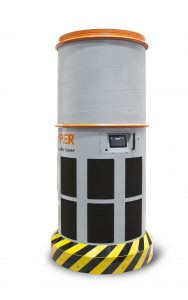 6. General ventilation systems for limited budgets and small environments
6. General ventilation systems for limited budgets and small environments
Previously, filter towers were widely equipped with cleanable and permanently usable high-performance filters. Recently, they have also been available with replaceable storage filters. This makes general ventilation systems affordable even for companies with limited budgets. They are particularly suitable for filtering out small amounts of dust.
In addition, general ventilation systems were long regarded as air purification systems for large production halls. Because the storage filters and thus the systems themselves are smaller, they can also be installed in plants with low ceiling heights. Other systems that rely on the displacement of contaminated air from the occupied zone can also be optimally adapted to smaller hall sizes.
7. Future guarantors of legally compliant production
Keeping to the current limit values in practice is a challenge today. Experts agree that in many cases a combination of measures is necessary. This gives general ventilation systems a completely new significance as a supporting system for source extraction.
In the structural steel sector, for example, the limit value for manganese in Germany of 0.02 mg/m³ (A dust) is already difficult to keep. Typically, this value is exceeded several times over, even if the general dust limit value is adhered to.
8. General ventilation systems for energy-efficient operation
The investment costs for general ventilation systems can be quickly amortised thanks to recirculating air solutions. The high-performance filters are able to effectively clean the contaminated air and return it to the production hall as recirculated air. This means that the already heated hall air can be reused and further heating of the hall air – especially in the cold season – is no longer necessary, reducing energy costs accordingly.
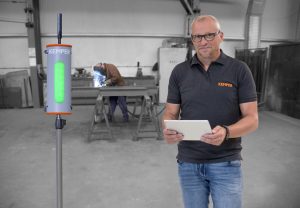 However, in the case of carcinogenic substances, such as from the welding of stainless steel, for example, general ventilation systems may only run in recirculation mode if they are being used in addition to source extraction.
However, in the case of carcinogenic substances, such as from the welding of stainless steel, for example, general ventilation systems may only run in recirculation mode if they are being used in addition to source extraction.
9. Digitally usable today
General ventilation systems can be integrated into today’s networked air pollution control concepts. Like KEMPER-Connect, they are IoT-capable and automatically connect to a Cloud that then controls the systems. This is made possible by permanent monitoring of the hall air. To ensure that dust limits are not exceeded in the first place, the Cloud independently starts up the systems according to defined specifications.
Consequently, the system acts completely autonomously when the air quality demands it. At the same time, this puts companies in a position to implement Smart Maintenance for the general ventilation systems. And those responsible for occupational health and safety have direct control over the success of general ventilation measures via the Cloud through the permanent measurement and evaluation of air quality.



